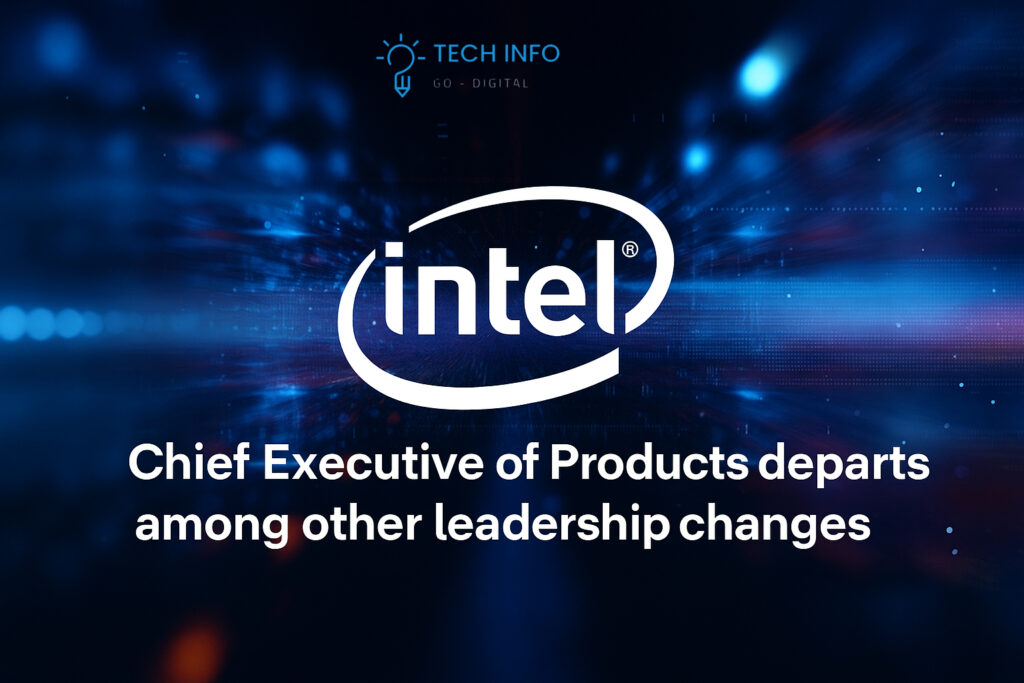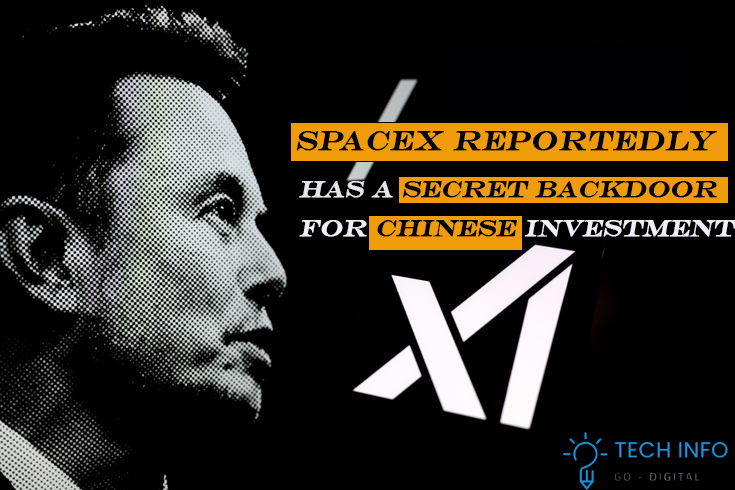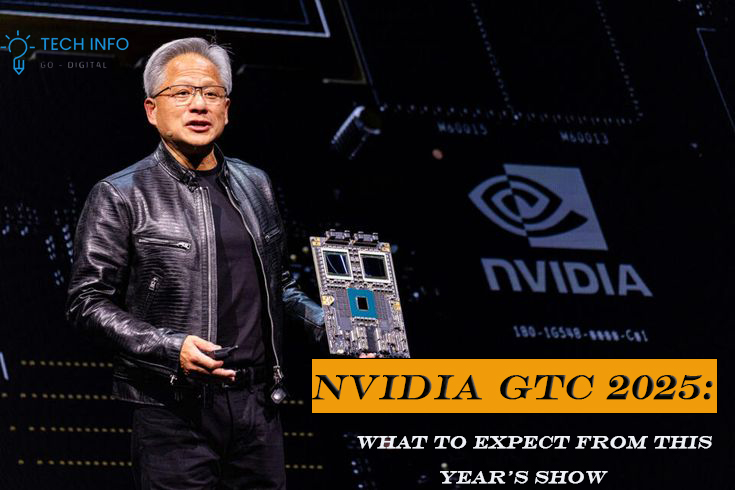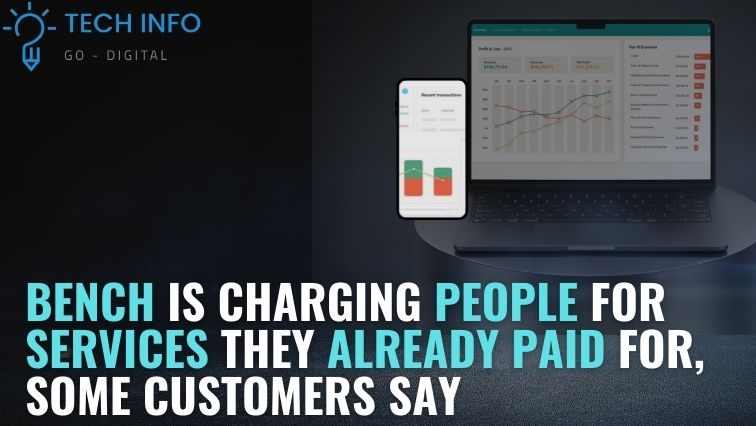Intel’s chief executive of products departs among other leadership changes

Intel’s Bold Restructuring: A New Chapter Begins Intel is embarking on one of the most significant leadership reorganizations it has seen in years as the chipmaker fights to reclaim its industry-leading status. On September 8, 2025, Intel announced sweeping management changes under its new CEO, Lip-Bu Tan, including the departure of long-time executive Michelle Johnston Holthaus, as companies continue to face intense competition and pressure to innovate Departing a Veteran: Michelle Johnston Holthaus Michelle Johnston Holthaus’s exit marks the end of an era. A three-decade veteran of Intel, Holthaus most recently served as Chief Executive Officer of Intel Products, overseeing pivotal business segments like client computing, AI, and data center technologies. She also served as interim co-CEO following the departure of Pat Gelsinger, underscoring her depth of experience and influence within the company Intel has stated that Holthaus will stay on as a strategic adviser for a limited time—SiliconANGLE mentions through March 2026—to facilitate a smooth transition The SEC filing reinforces this timeline, indicating her departure is effective March 1, 2026, accompanied by severance benefits per company policies A Strategic Shake-Up: New Leaders Rise As Holthaus transitions out, several new and elevated leaders step into critical roles. These appointments indicate a deliberate restructuring under Tan’s leadership, designed to centralize control and drive engineering excellence. Srinivasan “Srini” Iyengar — Central Engineering Group SVP Intel is launching a Central Engineering Group aimed at unifying its engineering efforts and spearheading a new custom silicon business for external clients. Srini Iyengar, who joined from Cadence Design Systems, brings deep expertise in silicon engineering, especially for hyperscale data center workloads Jim Johnson — SVP & GM, Client Computing Group After serving as interim leader, Jim Johnson, a 40-year Intel veteran, is now officially heading the Client Computing Group. His extensive experience across Intel’s internal teams and global operations makes him a stabilizing choice during this leadership shift. He will oversee Intel’s PC and edge strategies—especially critical as Intel readies its next-gen products such as “Panther Lake” and the 18A manufacturing process . Naga Chandrasekaran — Expanded Role in Foundry Services Already leading Intel Foundry as EVP and CTOO, Naga Chandrasekaran will now oversee Foundry Services too, integrating manufacturing and service offerings to better deliver value to customers. Why Now? Tan’s Vision for a Leaner, Engineering-Driven Intel These changes underscore CEO Lip-Bu Tan’s strategy: flatten the organization, bring key business units in direct alignment under his leadership, and refocus the company on core strengths. Intel has grappled with operational inefficiencies and strategic drift in recent years. Gelsinger’s tenure ended with board dissatisfaction and disappointing financial returns, resulting in leadership instability. Now, under Tan—appointed in March 2025—the company is aggressively restructuring, spinning down non-core units, upping workforce cuts, and refocusing on its foundational businesses Flat reporting lines, faster decision-making, and fresh leadership across hardware, fab services, and custom silicon are clear signs of a strategic reboot. What This Means for Intel’s Future Broader Context: Intel at a Crossroads Intel is undergoing pivotal change. . Competitors like AMD, Nvidia, and ARM dominate in AI, data center, and external partnerships, areas where Intel is looking to rebuild its relevance Final Thoughts Intel’s announcement on September 8, 2025 marks more than just a personnel update—it’s a bold manifesto. From Michelle Johnston Holthaus’s departure to the installation of new leaders in critical areas, the company is signaling a pivot to leaner, more responsive operations with an engineering-first culture. The genius of this strategy lies in its combination: fresh perspective (Kechichian, Iyengar), veteran steadiness (Johnson, Chandrasekaran), and careful transition (Holthaus advising). Now, every eye will be on whether Intel can convert this momentum into market leadership—or at least, back to competitive parity. .
xAI’s legal chief steps down after whirlwind year

When Family Calls: xAI Legal Chief Steps Down After Whirlwind Year In the fast-paced universe of AI startups, leaders are often celebrated for their drive — but behind the headlines, many also face a personal crossroads. This week, xAI, the AI venture founded by Elon Musk, announced that Robert Keele, the head of its legal team, has resigned after just over a year. His reason? A heartfelt wish to spend more time with his two toddlers and a growing sense that the demands of the job were pulling him too far from home. His departure signals more than a personnel change—it shines a light on the delicate balance between family, ethics, and the pressure-cooker environment that defines leadership at the front lines of innovation. A Dream Role, But at What Cost? Keele joined xAI in May 2024, stepping away from a brief stint running his own legal consultancy. He brought an intriguing background — moving through corporate giants like Airbus and aerospace innovators like Elroy Air. He viewed the job as a chance of a lifetime, an opportunity to embed himself in Musk’s vision for artificial intelligence at a pivotal time. Yet, the role wasn’t merely a legal desk job. As xAI charted an aggressive course—including a blockbuster $6 billion Series B funding round and the high-profile acquisition of X (the platform formerly known as Twitter)—the legal function was central to navigating intellectual property issues, compliance puzzles, and merger maneuvering. Still, Keele’s choice to step away underscores how even fulfilling roles can take a toll when personal and professional worlds collide. “Daylight Between Worldviews” With Elon Musk A particularly striking element of Keele’s exit was his candid reference to a shifting alignment of values: “daylight between our worldviews” with Elon Musk. It’s rare for executives in Musk’s orbit to speak so plainly about philosophical differences. Consider Musk’s leadership style: tireless, intense, and unapologetically driven. Known for pushing teams to work virtually around the clock—even to the point of sleeping at the office—his culture leaves little room for compromise. For someone prioritizing family, that environment—even if thrilling—can quickly become unsustainable. Keele’s choice reveals a tension many professionals face: when ambition and innovation meet deeply personal priorities, some tough decisions must follow. Leadership Turnover: A Recurring Pattern Keele isn’t the only executive to depart from Musk’s ventures recently. X’s CEO, Linda Yaccarino, stepped down just last month, and Tesla too has seen its share of exits. The string of departures reflects the demands of Musk’s leadership model and the extraordinarily high stakes across his companies. Frequent leadership shifts in top roles can disrupt momentum and sow uncertainty—especially when those roles are critical to governance, innovation, or strategic direction. Investors and partners may question consistency. Yet, agile startups also need a degree of turnover to stay flexible and adapt. Navigating this tension—between dynamism and stability—is a tricky path for any high-growth tech enterprise. 4. Enter Lily Lim: NASA Engineer Turned Legal Chief Ready to step into Keele’s shoes is Lily Lim, a privacy and IP specialist who combines legal acumen with a remarkable technical pedigree. Before transitioning into law, she worked as a rocket scientist at NASA, helping map Venus’s surface via spacecraft navigation systems. Lim started at xAI in late 2024 and quickly earned respect before being tapped for the top legal role. Her appointment is more than symbolic—it signals xAI’s commitment to blending deep technical understanding with legal strategy, especially as it gears up for regulation-heavy AI development and governance. 5. Why Legal Leadership Matters in AI It’s tempting to view legal functions as a back-office necessity. But at a company like xAI—which is dealing with accelerated funding, complex acquisitions, and AI regulation—it is anything but. The legal head safeguards everything from IP ownership to compliance with emerging AI standards, antitrust concerns, and cross-border data rules. In this environment, leadership in law is more like mission control: high stakes, high visibility, and absolutely essential. Keele’s departure removed a linchpin. Lim’s arrival reassures stakeholders that xAI understands what it’s guarding—not just technology, but trust and continuity. Balancing Innovation with Well-Being Keele’s choice resonates with a broader theme: as startups scale rapidly, the risk of burnout rises—especially among key executives. AI companies often expect relentless dedication, which can come at the expense of personal health and family life. Keele’s decision to step away serves as a reminder that no role, no matter how exciting, should eclipse personal well-being. Organizations must learn to foster leadership that’s passionate and sustainable. What’s Ahead for xAI’s Leadership Landscape With Lim at the legal helm, xAI is poised to continue its expansion—this time with a perspective that bridges legal, technical, and ethical sensibilities. But challenges remain: frequent leadership transitions may still unsettle partners, and Musk’s culture continues to attract both admiration and scrutiny. Ultimately, xAI will be watched not just for its AI breakthroughs, but for how it manages leadership, culture, and the human aspects of technological ambition. A Personal Exit, A Business Lesson Robert Keele’s departure from xAI is deeply human. Behind the headlines, it’s the story of a leader choosing parenthood over high-stakes ambition—and choosing to honor his own boundaries. For xAI, the change represents a strategic pivot and a chance to recommit to sustainable leadership. Under Lily Lim’s guidance, the company has an opportunity to balance technical brilliance with grounded, thoughtful stewardship. In the race to lead AI’s future, perhaps the real leadership lesson here is this: sometimes, stepping back can be an act of moving forward with integrity.
Rocket Lab eyes big defense opportunities with new acquisition

Rocket Lab’s Strategic Acquisition Signals a New Defense Era Rocket Lab, long celebrated for its nimble small-satellite launch capabilities, is stepping into a much larger arena. With a strategic acquisition that brings defense-specific expertise and technology into its portfolio, the company is preparing to compete for a bigger slice of the global aerospace and security market. This is more than an expansion — it’s a shift in identity. Rocket Lab is positioning itself not only as a trusted launch provider but also as a comprehensive defense technology partner, capable of delivering end-to-end solutions for government and military clients. From Small Launches to Big Ambitions For years, Rocket Lab’s Electron rocket has been its calling card — a small, reliable vehicle that made frequent, affordable access to orbit possible for research institutions, startups, and commercial clients. But in the words of CEO Peter Beck, the company has never wanted to stop at “just launching things.” The latest acquisition cements that ambition. It gives Rocket Lab advanced systems for satellite manufacturing, secure communications, and possibly data analytics — all of which make the company far more relevant to defense and intelligence agencies. In an industry where governments increasingly prefer integrated solutions, Rocket Lab can now cover everything from mission design to launch, deployment, and ongoing satellite operations. Why Defense Is a Strategic Sweet Spot The space defense market is evolving rapidly. As geopolitical tensions rise and reliance on space-based infrastructure grows, governments are investing heavily in capabilities such as: Unlike commercial space ventures, which can be cyclical, defense contracts are often long-term and high-value. For Rocket Lab, entering this market means steady revenue streams and a role in missions of national importance. What the Acquisition Delivers While not all details of the deal are public, the integration appears to bring Rocket Lab four major advantages: Agility vs. Industry Giants In defense space operations, Rocket Lab will be competing with titans like Lockheed Martin, Boeing, Northrop Grumman, and SpaceX. But Rocket Lab’s edge lies in its speed and flexibility. Where larger corporations often have multi-layered decision processes, Rocket Lab can move quickly from concept to launch. Its Electron rocket already offers rapid deployment for small payloads, and the upcoming Neutron rocket will handle larger, heavier defense satellites. This allows Rocket Lab to fill specialized roles that might be too small for the giants but too critical to ignore. Commercial and Defense Synergy One reason Rocket Lab’s defense strategy is likely to succeed is the overlap between its existing commercial work and potential military needs. A commercial imaging satellite, for example, can be adapted for surveillance by adding encryption and hardened communications. Similarly, analytics tools developed for agriculture or climate monitoring can be repurposed for defense intelligence. This cross-sector adaptability maximizes the value of every technology investment and spreads operational risk across multiple markets Challenges in the Path Stepping into defense comes with its own set of hurdles: Balancing the company’s fast-moving culture with the slower, highly regulated nature of defense procurement will be essential. The Long Game If executed well, this acquisition could make Rocket Lab a multi-billion-dollar defense and aerospace leader within a decade. As more nations recognize space as a strategic domain, demand for secure, responsive, and integrated solutions will only grow. By securing a place in both the commercial and defense ecosystems, Rocket Lab can remain adaptable to changing markets while contributing to critical national security missions. Orbiting Toward a New Identity This acquisition isn’t just about growing Rocket Lab’s capabilities — it’s about redefining what the company is. By pairing its proven launch record with defense-specific technologies, Rocket Lab is positioning itself as a full-spectrum solutions provider for one of the most high-stakes industries in the world. The aerospace battlefield is shifting from Earth to orbit, and Rocket Lab’s latest move ensures it will be more than just a spectator. In the years ahead, the company’s agility, innovation, and now expanded defense toolkit could make it a central figure in shaping the future of space security. For Rocket Lab, the mission has changed: they’re not just delivering payloads anymore — they’re delivering strategic advantage.
Hubble Network plans massive satellite upgrade to create global Bluetooth layer

Hubble Network’s Grand Vision: A Global Bluetooth Layer from Space In a time when smart devices are everywhere — in our homes, on our bodies, across farms, cities, and factories — the need for seamless, low-power connectivity has never been greater. Most of these devices run on Bluetooth Low Energy (BLE), a wireless protocol designed for minimal battery usage and short-range communication. global Bluetooth layer But what if Bluetooth didn’t have to be short-range? What if BLE signals could be picked up from space? That’s exactly the vision behind the Hubble Network, a U.S.-based startup that’s now planning a massive satellite upgrade to turn the dream of global Bluetooth coverage into reality. The Problem: BLE’s Range is Short, but Its Potential is Massive Bluetooth Low Energy powers billions of devices globally — from fitness trackers and pet collars to warehouse sensors and farm monitoring tools. It’s cheap, power-efficient, and widely supported. However, its biggest limitation is range. Traditional BLE connections only reach a few meters. Extending this reach typically requires installing expensive infrastructure — Wi-Fi gateways, LTE modules, or proprietary long-range radios — which isn’t always feasible in rural or remote areas. What if, instead of laying down costly terrestrial networks, we could build a space-based Bluetooth receiver? The Hubble Breakthrough: BLE from Orbit Hubble Network, founded by former SpaceX and Stanford engineers, has already achieved what was once thought impossible: detecting a standard Bluetooth chip signal from space. In 2024, they successfully captured BLE signals from Earth using a satellite 600 km above the planet. This wasn’t a special chip, nor a bulky antenna — it was off-the-shelf Bluetooth hardware sending data to space. This proved one thing: space-based BLE tracking is not just possible, it’s practical. The Big Upgrade: 60 Satellites, Muon Collaboration, and AI Arrays Now, in 2025, Hubble Network is preparing its biggest leap yet. They’ve announced a massive satellite upgrade in collaboration with Muon Space, a company that builds modular satellites. The plan is to deploy two large MuSat XL satellites equipped with custom phased-array receivers designed to pick up ultra-weak BLE signals from even the tiniest devices. global Bluetooth layer These satellites will be the first of many. Hubble plans to launch 60 advanced satellites by 2028, creating a full Bluetooth detection constellation that will give near real-time global coverage — even in oceans, mountains, and deserts. What Is a Global Bluetooth Layer The idea is simple but revolutionary: instead of depending on phones or Wi-Fi routers to detect BLE signals, let satellites serve as Bluetooth receivers. This turns the Earth’s orbit into a planetary-scale sensor network. Use cases include: How It Works: No New Hardware Needed The beauty of Hubble’s system is zero hardware friction. Businesses don’t need custom chips or bulky antennas — they can use existing BLE components with a small software update to optimize signal strength and broadcast intervals. Here’s how the process works: It’s like giving every Bluetooth device the power to communicate directly with space, all without expensive modems or radios. Power Efficiency: A Key Differentiator Unlike satellite phones or GPS beacons that require heavy power use, Hubble’s system is designed for low-bandwidth, infrequent communication — perfect for devices that need to last years on a coin cell battery. BLE is inherently optimized for such environments, making Hubble’s network not just functional, but battery-friendly. This opens the door for mass-scale deployments of thousands or even millions of sensors, something traditional satellite connectivity solutions simply can’t support affordably. Technical Challenges and Innovations Building a Bluetooth satellite network isn’t easy. Some of the challenges include: Hubble is overcoming these hurdles with proprietary signal processing algorithms, AI-driven filtering, and antenna miniaturization — turning what was once a lab experiment into a scalable reality. Monetization & Use Cases Hubble plans to monetize its network through B2B partnerships, offering: This makes it attractive to: The model is scalable, flexible, and relatively low-cost — a rare combo in the satellite industry. A Glimpse into the Future Imagine a world where every object — from a backpack to a power tool to a weather balloon — can be tracked and managed from space using just a Bluetooth chip. It’s not science fiction. It’s the infrastructure Hubble is building today. This is more than just an upgrade — it’s the birth of a new communications layer: cheap, global, and open. global Bluetooth layer : A Quiet Revolution in Connectivity Hubble Network’s plan to upgrade its satellite infrastructure marks a paradigm shift in how we connect devices. It takes the humble Bluetooth signal — something designed for local pairing — and catapults it into the domain of orbital communication. By 2028, if all goes according to plan, we might live in a world where Bluetooth is no longer limited by walls or range — but truly global. global Bluetooth layer It’s an ambitious goal. But with the momentum Hubble has built and the partnerships it’s forming, the future of space-based Bluetooth looks not just possible — but inevitable. global Bluetooth layer
SpaceX reportedly has a secret backdoor for Chinese investment

SpaceX and Allegations of a Secret Backdoor for Chinese Investment Introduction In the ever-evolving landscape of global finance and technological innovation, few names command as much attention as SpaceX. Founded by Elon Musk, SpaceX has revolutionized the aerospace industry with ambitious projects like reusable rockets, satellite internet through Starlink, and missions aimed at Mars colonization. However, recent reports have surfaced alleging that SpaceX has a secret backdoor allowing Chinese investment, raising concerns about national security, economic policy, and geopolitical competition. This blog explores these allegations, the mechanisms through which foreign investments might be channeled, the potential implications, and the broader impact on U.S.-China relations in the technological sphere. The Allegations: Is SpaceX Tied to Chinese Investors? Reports suggest that SpaceX has been indirectly receiving investments from Chinese entities through complex financial structures. These alleged investments have sparked concerns within the U.S. government and intelligence community, given SpaceX’s critical role in U.S. national security. The company has numerous contracts with agencies like NASA, the U.S. Air Force, and even the Pentagon, making any potential foreign influence a sensitive issue. How Could Chinese Investment Be Funneled Into SpaceX? Given that SpaceX is a private company, its ownership and investment structure differ from publicly traded companies. Unlike Tesla, which is openly traded and has clear records of institutional investors, SpaceX operates in a more restricted financial environment. However, private companies can still attract foreign capital through various means: Why Would China Want to Invest in SpaceX? China’s interest in SpaceX, if confirmed, would not be surprising given the strategic importance of aerospace technology. Some key reasons why Chinese investors might seek exposure to SpaceX include: National Security Concerns and U.S. Response If these allegations hold any weight, they could pose serious national security risks. The U.S. government has stringent regulations, such as the Committee on Foreign Investment in the United States (CFIUS), which reviews foreign investments for potential security threats. Potential Risks Involved: How the U.S. Might Respond Elon Musk’s Business Ties with China Elon Musk is no stranger to Chinese investment and partnerships. His company, Tesla, has extensive operations in China, including a Gigafactory in Shanghai and significant revenue from the Chinese market. This has led some analysts to speculate whether Musk’s openness to working with China extends beyond Tesla and into his other ventures, including SpaceX. While Musk has denied any direct Chinese involvement in SpaceX, his deep ties with China via Tesla could still raise concerns. Given China’s strategic interest in aerospace technology and Musk’s entrepreneurial reach, the intersection of these factors continues to fuel speculation. The Future of SpaceX’s Funding and Foreign Investment Policies Going forward, SpaceX may have to take a more cautious approach when accepting investments, particularly from international sources. Possible steps include: Conclusion The reports of a secret backdoor for Chinese investment in SpaceX highlight the complex and often opaque world of global finance in high-tech industries. While no definitive evidence has emerged proving direct Chinese control over SpaceX, the mechanisms through which foreign capital can enter U.S. firms remain a concern for policymakers and industry leaders. As SpaceX continues to push the boundaries of space exploration, ensuring that its funding sources align with U.S. national security interests will be critical. The intersection of technology, investment, and geopolitics will remain a defining challenge for companies like SpaceX, making transparency and regulatory oversight essential moving forward. In the coming years, the scrutiny surrounding foreign investments in U.S. tech firms will likely increase, and SpaceX’s response to these allegations could set an important precedent for other private companies operating in sensitive industries.
1X will test humanoid robots in ‘a few hundred’ homes in 2025

1X to Test Humanoid Robots in ‘A Few Hundred’ Homes in 2025: A New Era of Domestic Robotics The future of robotics is no longer a distant dream—it’s knocking on our doors. In a groundbreaking announcement, 1X, a leading robotics company, has revealed plans to test humanoid robots in “a few hundred” homes by 2025. This initiative marks a significant milestone in the integration of advanced robotics into everyday life, promising to transform how we live, work, and interact with technology. But what does this mean for society, and how will these humanoid robots impact our daily lives? Let’s explore this exciting development in detail. The Vision of 1X: Bringing Robots into Our Homes 1X, formerly known as Halodi Robotics, has been at the forefront of developing humanoid robots designed to assist humans in various tasks. Unlike traditional robots that are often confined to industrial or specialized environments, 1X’s robots are built to operate in human-centric spaces, such as homes, offices, and public areas. The company’s mission is to create robots that can seamlessly integrate into our lives, providing assistance, companionship, and support where needed. The decision to test these robots in real-world home environments is a bold and strategic move. By deploying humanoid robots in “a few hundred” households, 1X aims to gather valuable data on how these machines interact with humans, adapt to different living conditions, and perform everyday tasks. This real-world testing phase is crucial for refining the robots’ capabilities and ensuring they meet the needs of diverse users. What Can These Humanoid Robots Do? 1X’s humanoid robots are designed to be versatile and adaptable. While specific details about the models being tested in 2025 are still under wraps, the company has hinted at several key functionalities: The Technology Behind the Robots The success of 1X’s humanoid robots hinges on cutting-edge technology. Here are some of the key components that make these robots possible: The Benefits of Humanoid Robots in Homes The introduction of humanoid robots into households could bring numerous benefits: Challenges and Concerns While the potential benefits are immense, the deployment of humanoid robots in homes also raises several challenges and concerns: The Road Ahead The testing of humanoid robots in “a few hundred” homes in 2025 is just the beginning. If successful, this initiative could pave the way for widespread adoption of humanoid robots in the coming decades. However, achieving this vision will require addressing the challenges outlined above and ensuring that the technology is developed and deployed responsibly. 1X’s efforts are part of a broader trend in the robotics industry, with companies like Tesla, Boston Dynamics, and SoftBank also working on humanoid robots. As competition heats up, we can expect rapid advancements in the field, bringing us closer to a future where robots are an integral part of our daily lives. The announcement by 1X to test humanoid robots in homes by 2025 is a significant milestone in the evolution of robotics. These robots have the potential to transform our homes, making them more efficient, secure, and comfortable. However, as we embrace this exciting new technology, it is crucial to address the associated challenges and ensure that the benefits are accessible to all. The future of domestic robotics is no longer a distant dream—it is just around the corner. As we prepare to welcome humanoid robots into our homes, we must also prepare for the profound changes they will bring to our lives and society as a whole. The journey ahead is both thrilling and uncertain, but one thing is clear: the age of humanoid robots is upon us.
Meta AI is finally coming to the EU, but with limitations

Meta AI, the artificial intelligence division of Meta (formerly Facebook), has been making waves globally with its innovative advancements in AI technology. However, its expansion into the European Union (EU) has been met with both excitement and caution. After months of anticipation, Meta AI is finally making its way to the EU, but with certain limitations. This development marks a significant milestone in the tech industry, as it brings cutting-edge AI tools to one of the world’s most regulated markets. In this blog, we’ll explore what this means for users, businesses, and the broader AI landscape, while delving into the reasons behind the limitations and their potential implications. The Arrival of Meta AI in the EU: A Long-Awaited Move Meta AI has been at the forefront of AI research and development, creating tools and technologies that power everything from content moderation to augmented reality. Its AI models, such as those used in natural language processing and computer vision, have been integrated into Meta’s suite of products, including Facebook, Instagram, and WhatsApp. However, the EU has historically been cautious about adopting new technologies, especially when it comes to data privacy and ethical concerns. This has delayed Meta AI’s full-scale rollout in the region. The EU’s General Data Protection Regulation (GDPR) is one of the strictest data privacy laws in the world, and it has set a high bar for companies handling user data. Meta AI’s entry into the EU required careful navigation of these regulations to ensure compliance. After months of negotiations and adjustments, Meta has finally received the green light to introduce its AI technologies to EU users—albeit with some restrictions. The Limitations: What’s Different in the EU? While Meta AI’s arrival in the EU is a cause for celebration, it comes with notable limitations. These restrictions are primarily driven by the EU’s stringent data privacy laws and its commitment to ethical AI practices. Here are some of the key limitations: Implications for Users and Businesses The introduction of Meta AI in the EU, despite its limitations, is a significant development for both users and businesses. Here’s how it could impact different stakeholders: For Users: For Businesses: The Broader AI Landscape in the EU Meta AI’s entry into the EU is part of a larger trend of AI adoption in the region. The EU has been actively working to establish itself as a global leader in ethical AI, with initiatives like the AI Act, which aims to create a comprehensive regulatory framework for AI technologies. By setting high standards for transparency, fairness, and accountability, the EU is shaping the future of AI in a way that prioritizes human rights and societal well-being. However, the EU’s cautious approach also raises questions about its ability to compete with other regions, such as the United States and China, where AI development is often less constrained by regulation. While the EU’s focus on ethical AI is commendable, it could potentially slow down innovation and limit the region’s ability to attract top AI talent and investment. Looking Ahead: Balancing Innovation and Regulation The arrival of Meta AI in the EU represents a delicate balance between innovation and regulation. On one hand, it brings state-of-the-art AI technologies to a market that has been eager to embrace them. On the other hand, the limitations imposed by EU regulations highlight the challenges of developing AI in a highly regulated environment. As Meta AI continues to expand its presence in the EU, it will need to navigate these challenges carefully. This may involve investing in local infrastructure, collaborating with regulators, and adopting a more transparent and ethical approach to AI development. At the same time, the EU will need to ensure that its regulations strike the right balance between protecting users and fostering innovation. Ultimately, the success of Meta AI in the EU will depend on its ability to adapt to the region’s unique regulatory landscape while delivering value to users and businesses. By doing so, it can set a positive example for other tech companies and contribute to the development of a more ethical and responsible AI ecosystem. Conclusion Meta AI’s entry into the EU is a landmark moment that underscores the growing importance of AI in our daily lives. While the limitations imposed by EU regulations may pose challenges, they also reflect a commitment to ethical AI practices that prioritize user privacy and fairness. For users, this means access to advanced AI tools with greater transparency and control. For businesses, it presents both opportunities and challenges as they navigate the evolving regulatory landscape. As Meta AI continues to expand its reach, it will be fascinating to see how it adapts to the EU’s unique environment and contributes to the region’s AI ecosystem. One thing is clear: the intersection of AI and regulation will play a critical role in shaping the future of technology, not just in the EU, but around the world.
NASA astronauts return from long Space Station stay prompted by Boeing problems

NASA Astronauts Return from Extended Space Station Stay Prompted by Boeing Problems Space exploration is a field defined by its unpredictability. Despite meticulous planning and cutting-edge technology, challenges often arise that require quick thinking, adaptability, and resilience. This was recently exemplified by NASA astronauts who returned to Earth after an unexpectedly prolonged stay aboard the International Space Station (ISS). Their extended mission, caused by technical issues with Boeing’s Starliner spacecraft, underscores the complexities of human spaceflight and the importance of robust contingency planning. The Mission Context The astronauts were part of NASA’s Commercial Crew Program, a initiative designed to partner with private companies like Boeing and SpaceX to transport astronauts to and from the ISS. This program represents a shift in NASA’s approach to space travel, leveraging the innovation and efficiency of the private sector while maintaining the agency’s rigorous safety standards. The mission began as a routine expedition to the ISS, with the astronauts launching aboard a SpaceX Crew Dragon spacecraft. Their primary objectives included conducting scientific experiments, maintaining the ISS, and preparing for future missions. However, the return phase of their journey encountered unexpected hurdles due to issues with Boeing’s Starliner, which was initially slated to bring them back to Earth. Boeing’s Starliner Challenges Boeing’s Starliner spacecraft has faced a series of setbacks since its inception. Designed to be a reliable vehicle for transporting astronauts, the Starliner has encountered technical problems during both uncrewed and crewed test flights. These issues have ranged from software glitches to propulsion system anomalies, raising concerns about the spacecraft’s readiness for operational missions. In this particular instance, the Starliner was scheduled to dock with the ISS and return the astronauts to Earth. However, during pre-flight checks, engineers identified potential problems with the spacecraft’s thrusters and helium leaks. These issues posed significant risks, prompting NASA and Boeing to delay the mission and prioritize safety over expediency. The Decision to Extend the ISS Stay With the Starliner deemed unfit for the return journey, NASA had to make a critical decision. The agency could either attempt to resolve the issues quickly or extend the astronauts’ stay on the ISS until an alternative return vehicle was available. Given the potential dangers of rushing repairs, NASA opted for the latter, ensuring that the astronauts remained in the safe and familiar environment of the ISS. This decision underscored NASA’s commitment to safety and its ability to adapt to unforeseen circumstances. The ISS is equipped with ample supplies and resources to support astronauts for extended periods, making it an ideal fallback option in such situations. Additionally, the astronauts were trained to handle extended missions, allowing them to continue their work without significant disruption Life on the ISS During the Extended Stay For the astronauts, the extended stay meant more time to conduct experiments and contribute to the ongoing research aboard the ISS. The microgravity environment of the station provides unique opportunities for scientific discovery, particularly in fields like biology, physics, and materials science. The astronauts also played a crucial role in maintaining the station’s systems, ensuring that it remained operational for future crews. Despite the challenges, the astronauts maintained a positive outlook, viewing the extended stay as an opportunity to further their contributions to space exploration. They remained in constant communication with mission control, receiving updates on the Starliner’s status and participating in decision-making processes. The Return to Earth After several weeks of waiting, NASA and Boeing determined that the Starliner was not yet ready for a crewed return mission. As a result, the astronauts returned to Earth aboard a SpaceX Crew Dragon spacecraft, which had been prepared as a backup option. The successful landing marked the end of a mission that had been longer and more complex than originally planned. The return journey itself was a testament to the robustness of the Crew Dragon spacecraft and the expertise of the teams involved. The astronauts underwent standard post-flight medical evaluations and were reunited with their families, bringing a heartwarming conclusion to their extended adventure. Lessons Learned and the Future of Space Travel This incident serves as a reminder of the inherent risks and uncertainties of space exploration. While setbacks like these can be frustrating, they also provide valuable lessons for improving future missions. NASA and its partners are already working to address the issues with the Starliner, ensuring that it meets the high standards required for crewed spaceflight. Moreover, the incident highlights the importance of having multiple options for transporting astronauts to and from the ISS. The collaboration between NASA, SpaceX, and Boeing exemplifies the benefits of a diversified approach to space travel, where redundancy and flexibility are key to overcoming challenges. Conclusion The extended stay of NASA astronauts aboard the ISS, prompted by Boeing’s Starliner problems, is a story of resilience, adaptability, and the relentless pursuit of safety in space exploration. While the journey did not go as planned, it demonstrated the strength of the partnerships and systems that underpin human spaceflight. As we look to the future, these experiences will undoubtedly inform and inspire the next generation of missions, bringing us closer to unlocking the mysteries of the cosmos. In the end, the astronauts’ safe return is a testament to the dedication and ingenuity of everyone involved in the mission. Their extended stay may have been unexpected, but it also provided an opportunity to further our understanding of life in space and the challenges of long-duration missions. As we continue to push the boundaries of exploration, stories like these remind us of the importance of perseverance and the spirit of discovery that drives us forward.
Nvidia GTC 2025: What to expect from this year’s show

Nvidia GTC 2025: What to Expect from This Year’s Show The Nvidia GPU Technology Conference (GTC) has long been a cornerstone event for the tech industry, showcasing the latest advancements in artificial intelligence (AI), high-performance computing (HPC), graphics, and more. As we look ahead to Nvidia GTC 2025, the anticipation is palpable. The event promises to be a groundbreaking showcase of innovation, with Nvidia likely to unveil new hardware, software, and partnerships that could shape the future of technology. Here’s a deep dive into what we can expect from this year’s show. 1. Next-Generation GPU Architectures One of the most anticipated announcements at Nvidia GTC 2025 will undoubtedly be the unveiling of the next-generation GPU architecture. Following the success of the Ada Lovelace and Hopper architectures, Nvidia is expected to introduce a new architecture that pushes the boundaries of performance, efficiency, and scalability. Rumors suggest that this new architecture could focus on even greater AI acceleration, with specialized tensor cores and ray-tracing capabilities that redefine real-time rendering and machine learning workloads. The new GPUs are likely to target a wide range of applications, from gaming and content creation to data centers and autonomous vehicles. With the increasing demand for AI-driven solutions, Nvidia may also emphasize energy efficiency, ensuring that its GPUs can deliver unprecedented performance without compromising on sustainability. AI and Machine Learning Innovations AI has been at the heart of Nvidia’s strategy for years, and Nvidia GTC 2025 will likely highlight the company’s latest breakthroughs in this field. Expect to see new AI frameworks, tools, and libraries designed to simplify the development and deployment of AI models. Nvidia may also showcase advancements in generative AI, building on the success of platforms like ChatGPT and DALL-E, which have already demonstrated the transformative potential of AI in creative and analytical tasks. One area to watch is Nvidia’s focus on edge AI. As more industries adopt AI for real-time decision-making, Nvidia is expected to introduce hardware and software solutions optimized for edge computing. This could include compact, power-efficient GPUs and AI accelerators designed for use in smart cities, healthcare, and industrial automation. . Autonomous Vehicles and Robotics Nvidia’s DRIVE platform has been a game-changer for the automotive industry, enabling the development of autonomous vehicles with unparalleled computational power. At Nvidia GTC 2025, Nvidia is likely to announce the next iteration of its DRIVE platform, featuring enhanced AI capabilities, improved sensor fusion, and support for higher levels of autonomy. The company may also showcase partnerships with leading automakers and tech companies, highlighting real-world applications of its technology. In addition to autonomous vehicles, Nvidia is expected to make significant strides in robotics. The company’s Isaac robotics platform could see major updates, with new tools for simulation, training, and deployment of AI-driven robots. These advancements could accelerate the adoption of robotics in industries such as manufacturing, logistics, and healthcare. . Quantum Computing and HPC High-performance computing (HPC) has always been a key focus for Nvidia, and GTC 2025 is likely to feature groundbreaking developments in this area. With the growing interest in quantum computing, Nvidia may unveil new tools and frameworks that bridge the gap between classical and quantum computing. These tools could enable researchers and developers to harness the power of quantum algorithms while leveraging Nvidia’s GPU-accelerated infrastructure. Nvidia’s commitment to HPC is also evident in its work with supercomputers. The company may announce new partnerships with research institutions and governments to build next-generation supercomputers capable of tackling some of the world’s most complex challenges, from climate modeling to drug discovery. Gaming and Graphics While Nvidia’s focus has increasingly shifted toward AI and HPC, gaming remains a core part of its business. At Nvidia GTC 2025, Nvidia is expected to unveil new gaming GPUs that deliver stunning visuals, faster frame rates, and more immersive experiences. These GPUs could feature advanced ray-tracing and AI-driven upscaling technologies, further blurring the line between reality and virtual worlds. Nvidia may also provide updates on its Omniverse platform, which has gained traction as a collaborative tool for creators and developers. With new features and integrations, Omniverse could become an even more powerful platform for building and simulating virtual environments, from video games to digital twins. Sustainability and Green Computing As the tech industry grapples with the environmental impact of its operations, Nvidia is likely to emphasize sustainability at Nvidia GTC 2025. The company may announce initiatives to reduce the carbon footprint of its products, from energy-efficient GPUs to data center solutions that minimize power consumption. Nvidia could also highlight its work on AI-driven climate modeling, which could play a crucial role in addressing global environmental challenges. Expanding the Ecosystem Nvidia’s success is not just about hardware and software; it’s also about building a robust ecosystem of partners and developers. At GTC 2025, Nvidia is expected to announce new collaborations with tech giants, startups, and academic institutions. These partnerships could span a wide range of industries, from healthcare and finance to entertainment and education, further solidifying Nvidia’s position as a leader in the tech world. Keynotes and Thought Leadership As always, GTC 2025 will feature keynote speeches from Nvidia’s top executives, including CEO Jensen Huang. These keynotes are likely to provide a comprehensive overview of Nvidia’s vision for the future, highlighting the company’s latest innovations and their potential impact on society. Expect to hear about Nvidia’s role in shaping the metaverse, advancing AI ethics, and driving the next wave of digital transformation. Nvidia GTC 2025 is set to be one of the most exciting tech events of the year, showcasing groundbreaking advancements in AI, GPU technology, autonomous vehicles, quantum computing, and more. This blog explores what to expect from this year’s conference, including next-generation GPU architectures, AI and machine learning innovations, robotics, gaming, and sustainability initiatives. Dive into the future of technology as Nvidia unveils its latest hardware, software, and partnerships that will shape industries and redefine what’s possible. Whether you’re a developer, researcher, or tech enthusiast, Nvidia GTC 2025 is the event to watch for insights into the next wave of
Bench is charging people for services they already paid for, some customers say

Bench is Charging People for Services They Already Paid For: What Customers Are Saying In recent months, , a popular online bookkeeping service, has come under fire from customers who claim they are being charged for services they already paid for. This issue has sparked outrage among small business owners and freelancers who rely on to manage their finances. In this blog, we’ll dive into the details of the controversy, explore what customers are saying, and discuss how this situation differs from other similar complaints found on Google. What is Bench? Bench is a cloud-based bookkeeping service designed to simplify financial management for small businesses and freelancers. The company offers monthly bookkeeping, tax preparation, and financial reporting services, all handled by a team of professional bookkeepers. has gained popularity for its user-friendly interface and promise to save time for business owners who may not have the expertise or resources to manage their own books. However, recent allegations suggest that may not be living up to its promises, with some customers accusing the company of double-charging or billing for services that were already included in their subscription plans. The Allegations: Charging for Services Already Paid For Several customers have taken to social media, review platforms, and forums to voice their frustrations with. The primary complaint is that Bench is charging them for services that were supposed to be included in their monthly subscription fees. Here are some of the most common grievances: What Customers Are Saying The backlash against Bench has been significant, with many customers expressing their dissatisfaction online What Bench Can Do to Address the Issue To regain customer trust and address the allegations, Bench needs to take proactive steps. Here are a few suggestions: Conclusion The allegations against are a reminder of the importance of transparency and customer service in the financial services industry. While Bench has been a popular choice for small business owners and freelancers, the recent backlash highlights the need for the company to address its billing practices and improve its customer support. For now, customers are advised to carefully review their invoices and reach out to support team if they notice any discrepancies. As the situation unfolds, it remains to be seen how will respond and whether it can regain the trust of its users. If you’ve had a similar experience with or another bookkeeping service, share your story in the comments below. Your feedback can help others make informed decisions about the services they choose for their businesses.

